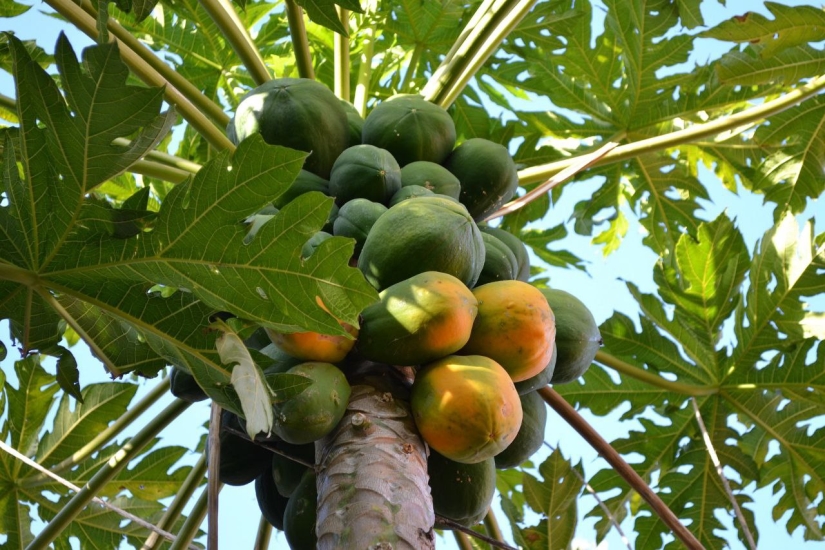
Pawpaw farming in Kenya is primarily carried out in tropical and subtropical climates, as pawpaw plants are not tolerant of freezing temperatures. Papaya fruits, known for their delicious taste, can be grown throughout the year. These fruits are commonly eaten alone or used in salads without the skin. Papayas are low in calories and rich in potassium, vitamin A, and vitamin C.
Benefits of Pawpaw to Humans
The enzymes present in papayas promote digestion and help ease constipation. They are also effective in controlling colon infections and reducing the risk of colon cancer. Papaya plants are short-lived perennial trees with an economic lifespan of about 4 years, although they can live up to 10 years. This means that papaya orchards need to be renewed every 4-5 years to maintain profitability. There are three groups of pawpaw distinguished by their primary sex, which is reflected in their flowers:
- Female plants: These trees only produce female flowers, which are usually single blooms. Female flowers are larger and located close to the trunk.
- Male plants: These trees only produce male flowers, characterized by long, thin stalks with multiple small blooms.
- Hermaphrodite trees: These trees produce both male and female flowers. It is recommended to initially plant 4 trees per hole and later thin them out to single trees when the flowers appear. Consult a gardening advisor for assistance in identifying the flowers.
Common Varieties of the PawPaw
- Solo variety: This variety produces small, round, sweet fruits with uniform size and shape. It is hermaphroditic and popular for both the local and export markets.
- Mountain variety: This variety thrives at high altitudes and produces small fruits suitable for making jam and preserves.
- Sunrise variety: Known for its smooth pear-shaped fruit of high quality, weighing between 400 and 650 grams.
- Red Royale: An improved breed that yields good-quality fruits.
- Golden Caliman: Best suited for export purposes.
Tissue culture propagation is a recommended method for vegetative propagation of papayas. This technique results in superior plants that are disease-resistant, high-yielding, and easy to maintain and harvest due to their shorter stature.
Papaya Fruit Farming in Kenya
Papayas require warm to hot climates for optimal growth, preferably at an altitude below 2100 meters above sea level. The ideal annual rainfall is around 1000mm, which should be well-distributed. The growing soils should be deep, well-drained, and have adequate moisture without being waterlogged.
Papayas can be grown from seeds extracted from healthy papaya fruits and trees. The seeds can be directly sown or first grown in a nursery.
Direct sowing involves placing 6 seeds per hole, which are later thinned to four plants per hole after germination. After flowering, only one plant per hole should be retained. In cases where male and female flowers are borne on different trees, male trees should be planted at a ratio of 25:100 (male:female) for pollination.
For nursery practices, seedlings are best raised in 12cm x 20cm black poly bags. The soil media for the nursery can be purchased or prepared locally by mixing one part sub-soil with one part well-decomposed manure. Soaking the seeds for 48 hours before sowing helps break dormancy. The seedlings should be gradually exposed to sunlight to harden them before transplanting.
When planting in the field, seedlings should be spaced at 1.8m x 2m or 2m x 2.5m, with approximately 2,800 to 4,000 plants per hectare. Thinning out should be done after the first flush of flowers appears, retaining only sturdy plants with hermaphrodite flowers.
Weeding & Irrigation needs
Weed control is important and can be achieved through shallow hand weeding to avoid damaging the roots.
Irrigation is crucial for maintaining vigorous plant growth. During the dry season, it is recommended to irrigate to achieve a total of 150 to 200 mm of water per month. Supplementary irrigation methods such as drip irrigation or micro sprinklers can be employed to improve yields and reduce flower abortion.
Fertilizer application should be based on soil analysis. A general recommendation is to apply 114g of Triple Super Phosphate (TSP) per hill at planting, along with well-decomposed manure. The rates of fertilizer application vary depending on the age of the plants, ranging from 50g to 100g of Urea and Potassium Sulphate at different stages.
Pest and disease control is essential in papaya farming. Common pests like spider mites and thrips can be controlled using Sulphur 80WP at the recommended dosage. Spraying should be done early in the morning or late in the evening.
By following these guidelines, farmers can engage in successful papaya fruit farming in Kenya, benefiting from its high market demand and nutritional value.
For more information or guidance on papaw farming reach out to us via jilisheafrica@gmail.com